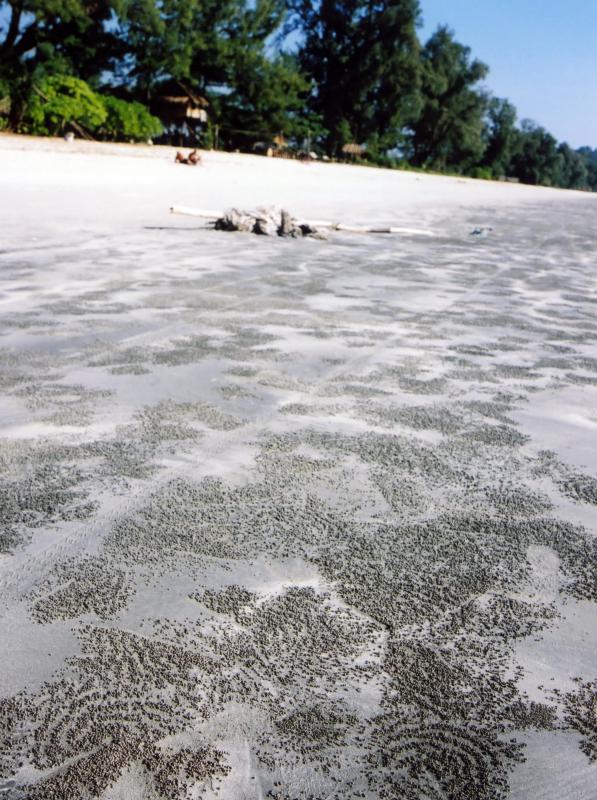At AllThingsNature, we're committed to delivering accurate, trustworthy information. Our expert-authored content is rigorously fact-checked and sourced from credible authorities. Discover how we uphold the highest standards in providing you with reliable knowledge.
What Are Acorn Worms?
Acorn worms are a type of aquatic invertebrate that lives in burrows on shorelines or in shallow waters. The name of the worm comes from the acorn-shaped segment at the front end of its body. There are close to 100 types of these worms, ranging in size from 1/25th of an inch to nearly 8 feet long (1 millimeter to 2.5 meters). The worms eat material that can be found in the sand in which they create their burrows or floating freely in the water around them.
The family of animals to which acorn worms belong is called the Hemichordata, and the worms themselves are also known as enteropneusts. They are very closely related to another class of sea creatures that includes sea stars, displaying a common lineage based on their distinctive anatomical features. The anatomy of the worms has led to scientists studying them as one of the linking species between vertebrates and invertebrates.

One of the defining features of acorn worms is the way their bodies are arranged. Their bodies have three sections, starting with the acorn-shaped area on the front end of the worm. This acorn is an organ used to help the worm burrow into the ground and to help draw food into the body to be processed.
The second part of the body is called the collar, and it helps to seat the acorn organ. The final area is known as the trunk. The entire body is covered in small hairs known as cilia. The acorn worms use these hairs to help them move, burrow and direct food into their mouths. As they grow, the worms continually develop gill slits in two lines along the length of their bodies; these are used mainly for breathing.

Internally, acorn worms have two hollow nerve cords. These nerve cords indicate that the worms are related to ancient vertebrates. Their development of gill slits means they also are related to a class of animals known as chordates. This combination of ancestry is studied because it could mean these worms are the link between these two types of animals.
Acorn worms spend nearly all of their time in burrows or under other protective structures such as rocks, so they are almost never seen by humans in the wild. Instead, evidence of the worms can be found in their castings. The worms raise the end of their bodies out of their burrows and release a long string of digested sand, minerals and other excrement. These castings form ribbons that remain on the bottom of the water around their burrows.
Frequently Asked Questions
What exactly are acorn worms?
Acorn worms are marine invertebrates belonging to the phylum Hemichordata, closely related to chordates, the group that includes vertebrates. They are named for their acorn-shaped proboscis, which is used for burrowing and feeding. These worms play a crucial role in marine ecosystems by recycling nutrients as they process sediment.
Where can acorn worms be found?
Acorn worms inhabit a range of marine environments, from shallow intertidal zones to the deep sea. They are particularly common in soft sediment areas such as mudflats and sandy bottoms. Some species are known to dwell at depths of over 2,500 meters, showcasing their adaptability to various oceanic conditions.
How do acorn worms feed and what is their diet?
Acorn worms are deposit feeders, consuming organic particles from the sediment. They use their proboscis to both burrow and collect food, often leaving behind characteristic spiral-shaped fecal casts on the sea floor. Their diet mainly consists of detritus, microorganisms, and decaying matter, which they filter from the sediment.
Do acorn worms have any significance in scientific research?
Yes, acorn worms are of significant interest in evolutionary biology. Their body plan exhibits both invertebrate and vertebrate characteristics, providing insights into the evolution of chordates. Research on their regenerative abilities, particularly their capacity to regrow body parts, offers potential breakthroughs in understanding tissue regeneration and healing in humans.
What is the lifespan of an acorn worm?
The lifespan of acorn worms varies by species, but many can live for several years. Some larger species are believed to live for more than a decade. Their longevity can be attributed to their low predation rates and efficient regenerative capabilities, allowing them to recover from injuries that might be fatal to other organisms.
Are acorn worms endangered or threatened?
Most acorn worm species are not currently classified as endangered or threatened. However, their habitats can be vulnerable to human activities such as bottom trawling, pollution, and coastal development. Protecting their environments is essential to ensure the survival of these unique creatures and the health of marine ecosystems they support.
AS FEATURED ON:
AS FEATURED ON:












Discussion Comments
I think they eat sand and mud, or least swallow it and somehow digest any edible bits that might be in it. I could be wrong, but that's what I've heard.
They also secrete what their bodies can't process, and this is called cast. Seeing cast is a good indicator that the acorn worm is nearby. I don't think they come out of their burrows very often.
What do these worms eat? I'm just curious because if they live in the water and burrow, do they eat small fish or other water creatures?
When I watch television shows about burrowing water dwellers they often trap nab their prey as they swim by.
Post your comments